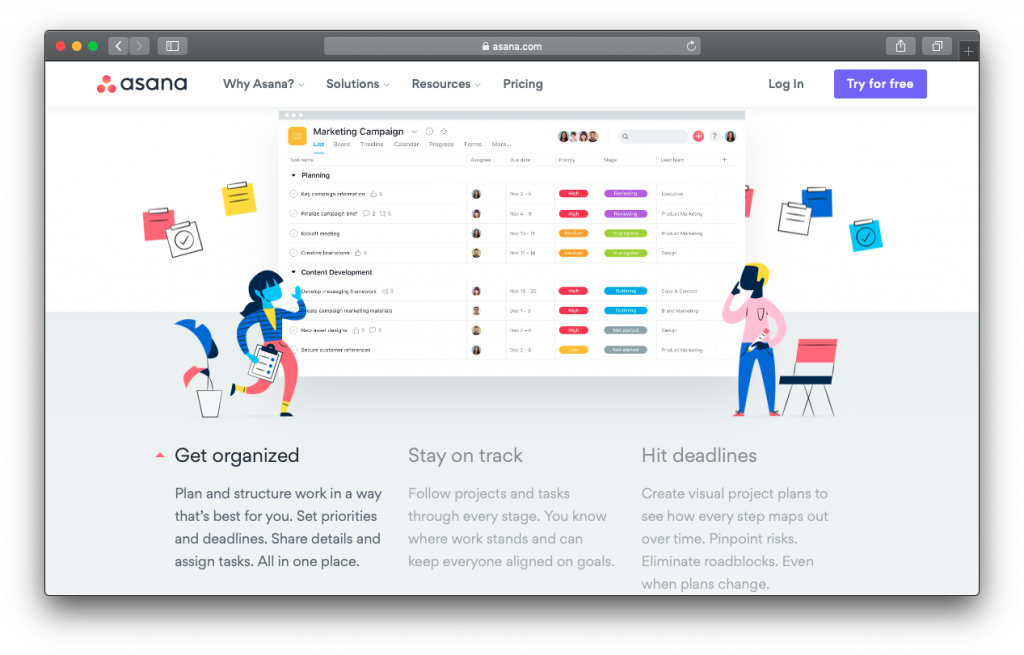Asana is a cloud-based project management software solution designed to enable easier team collaboration and automate daily work operations. It does this through a bevy of powerful features such as updated activity feed, email bridge, project permissions, timelines and more. Users experience an advanced and interactive platform to work with their team. Other functionalities include the ability to track projects and set priorities.
In managing and completing projects, employees often work under certain pressures and circumstances. Without the right tools to keep track of their progress, as well as if other members of their team have completed their tasks, businesses can easily suffer major setbacks and miss deadlines. Asana fixes these challenges by giving users a platform to collaborate with their team as they work.
Asana is catered for businesses of all sizes. Its features help users manage team projects, stay on top of tasks and automate work processes. Before, teams within different departments had to deal with scheduled meetings, long email threads and confusing spreadsheets. But now, Asana provides a better and smarter alternative for you to accomplish tasks faster.
Asana Features
Asana has several proprietary features to assist businesses in managing their projects. It offers an easy-to-use and feature-rich platform for you to work with. It’s catered for a varying level of difficulties—from small projects to bigger and strategic initiatives.
Project management
Asana’s project management features help users during each step of a project, such as planning, organizing, managing and finalizing. Most of these tools also act as a collaboration tool. They help users in four different ways:
Engineering – users are given the ability to file and track reports and sprints in their projects. You are notified of any changes and issues along the way.
Marketing – you can plan events and activities ahead of time with the help of calendar integration; this makes it easier to keep track of all the things you must first.
Sales – lead generation primarily works under this category. Users can better handle prospects first and efficiently manage their customer accounts.
Human resources – this feature lets you manage candidates and the whole onboarding process with a checklist of tasks that need to be done.
Agile management
This feature guides users in planning and guiding projects through a collaborative effort between cross-functional teams and their end-users. This lets you be more flexible in terms of tracking launches, simplifying projects and communication with teammates through the following tools: spring planning, bug tracking, product feedback and conversations.
Kanban boards
Kanban boards give you visualization over your impending tasks and unfinished activities. This helps your team members track what’s already been completed and which part of the project needs to be dealt with.
Timeline
Spreadsheets offer little to no functionalities when it comes to going beyond planning and organizing. Asana’s platform, on the other hand, helps you keep relevant project details in one centralized location, build and maintain plans and manage several ongoing activities at once. You don’t need Excel spreadsheets if you have Asana’s Timeline feature, which plots out your project timelines, scheduled tasks and member’s assigned tasks.
Task management
Asana’s task management feature isn’t just a list of all the things your team must complete by the end of the day. Instead, it’s a tool for you to track tasks, delegate subtasks and set deadlines for your members. This keeps you organized and on top of what you need to get done.
Calendar integration
What this feature does is it provides you with a calendar view of what your team needs to get done during an expected period. It also helps you know which deadlines must be met and what your members are currently doing. You also have the option to switch your view between calendars and lists.

Asana Benefits
Asana offers a range of benefits for its users:
Centralized software solution
If you’re tired of switching between several applications just to finish a project, then Asana has a smarter alternative for you. With a single, centralized location for your tasks and projects, you can work faster and more productively with your tasks. You can see where everything stands and see a bigger picture of your business’s performance.
Intuitive timeline
With Asana’s Timeline feature, you can see the pace and progress of your projects. It’s good for visualization and flexibility, especially if certain tasks need to be prioritized first. If you currently have several projects going on simultaneously, then having a timeline of them helps keep you on track and on top of things.
Automated work operations
Don’t worry about tasks taking up most of your time and benefit from Asana’s workflow automation. These features simplify the workload, eliminate any errors and inaccuracies and reduce the time it usually takes for you to complete your tasks.
Project portfolios
In your project portfolios, you can compile company objectives, marking tasks, people operations, sales funnels, customer operations and finance details. It’s a compilation of everything you need to know about a specific project, which is helpful in monitoring your progress and keeping your team updated.
Asana Pricing
Asana is divided into four pricing packages, which are catered for varying business sizes. Varying levels of functionalities and several advanced features differ according to the pricing package you’d choose. If you want to test out the solution’s features first to get an initial feel of what you can do within the platform, then you should try the free version.
Basic
Basic is the free version of Asana. It’s catered for individuals or teams with little to no experience in project management. It has basic features that allow you to work within limited functionalities and communicate well with your team. You can collaborate up to 15 teammates and assign tasks and due dates to your members.
Premium
Priced at $10.99 per month and per user, Premium is designed for teams that need to be confident in creating project plans. It offers more advanced features compared to the previous plan, since users can now better track team projects with its premium tools. These tools include the following: Timeline, advanced search and reporting, custom fields and an admin console.
Business
Business offers a project management platform for teams and companies who need to manage work across initiatives. It costs $24.99 per user and per month. It has everything Premium offers but with additional key features. This includes Portfolios, Workload, Custom rules builder (an automated tool that allows you to write your own rules) and Adobe Creative Cloud integration.
Enterprise
Enterprise doesn’t have a fixed price which means you have to contact Sales to get a quotation. It’s suitable for organizations in need of additional control, support and security. It has all the features found in Premium but with additional ones such as SAML, data export and deletion, block native integrations and priority support.
Conclusion
If you’re looking for a software solution that’s easy to use, has good mobile applications and offers a free plan, then Asana is one of the top contenders. Businesses in need of a good project management platform can rely on Asana to keep their work organized, team members updated, and projects accomplished. It also allows for improved efficiency and increased productivity in your daily operations.

